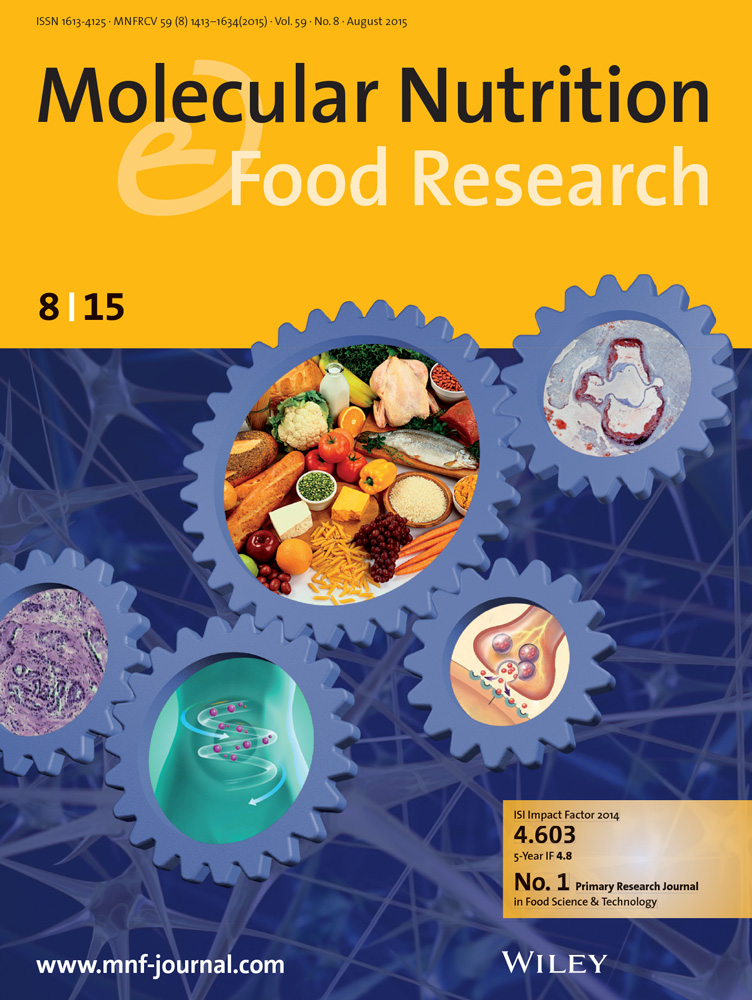槲皮素代谢物对 3T3-L1 脂肪细胞中葡萄糖依赖性脂质积累的影响
IF 4.5
2区 农林科学
Q1 FOOD SCIENCE & TECHNOLOGY
引用次数: 0
摘要
本研究的目的是评估槲皮素代谢产物(QMs)在高糖和生理葡萄糖浓度下对脂肪细胞脂质积累的影响,并阐明其机制。3T3-L1成熟脂肪细胞暴露于生理葡萄糖浓度下,作为热量限制(CR)或高葡萄糖(对照)的模型,有或没有QMs(槲皮素-3-葡糖苷[Q3G]和异鼠李素[ISOR])。细胞用Q3G(0.3和0.6µmol/L)和ISOR(0.2和0.4µmol/L)处理48小时。脂质积累(油红O染色)和Δ葡萄糖水平(HPLC)。在高糖条件下,Q3G和ISOR降低了脂质积累(- 10.8%和- 10.4%;p & lt;0.01)和Δ血糖水平(- 13.6%和- 14.2%;p & lt;0.05)。CR下,QMs提高Δ血糖水平(Q3G +21.6%, ISOR +21%);p & lt;0.05)。ISOR使高糖组pAMPK水平升高(+1.4倍;p & lt;0.05)。CR下,Q3G和ISOR使pAMPK增加了+1.4倍和+1.5倍;p & lt;0.05),而ISOR上调SIRT1和PGC-1α(+2.3-和+1.5倍;p & lt;0.05)。研究结果首次支持QMs,特别是ISOR在体外调节脂质代谢中的潜在贡献,可能通过AMPK激活。鼓励进一步的研究,包括体内研究,以加强所观察到的机制的证据。本文章由计算机程序翻译,如有差异,请以英文原文为准。

Effects of Quercetin Metabolites on Glucose-Dependent Lipid Accumulation in 3T3-L1 Adipocytes
The aim of the study was to assess the effects of quercetin metabolites (QMs) on lipid accumulation in adipocytes under high-glucose and physiological-glucose concentrations and to elucidate the mechanisms involved. 3T3-L1 mature adipocytes were exposed to a physiological glucose concentration, as a model of caloric restriction (CR), or high glucose (control), with and without QMs (quercetin-3-glucuronide [Q3G] and isorhamnetin [ISOR]). Cells were treated with Q3G (0.3 and 0.6 µmol/L) and ISOR (0.2 and 0.4 µmol/L) for 48 h. Lipid accumulation (Oil Red O staining) and Δ glucose level (HPLC) were assessed. Under high glucose, Q3G and ISOR reduced lipid accumulation (−10.8% and −10.4%; p < 0.01) and Δ glucose level (−13.6% and −14.2%; p < 0.05). Under CR, QMs increased Δ glucose level (+21.6% for Q3G and +21% for ISOR; p < 0.05). ISOR increased pAMPK levels under high glucose (+1.4-fold; p < 0.05). Under CR, Q3G and ISOR increased pAMPK (+1.4- and +1.5-fold; p < 0.05), while ISOR upregulated SIRT1 and PGC-1α (+2.3- and +1.5-fold; p < 0.05). Findings support, for the first time, the potential contribution of QMs, especially ISOR, in the regulation of lipid metabolism in vitro, possibly via AMPK activation. Further studies, including in vivo, are encouraged to strengthen evidence of the mechanisms observed.
求助全文
通过发布文献求助,成功后即可免费获取论文全文。
去求助
来源期刊

Molecular Nutrition & Food Research
工程技术-食品科技
CiteScore
8.70
自引率
1.90%
发文量
250
审稿时长
1.7 months
期刊介绍:
Molecular Nutrition & Food Research is a primary research journal devoted to health, safety and all aspects of molecular nutrition such as nutritional biochemistry, nutrigenomics and metabolomics aiming to link the information arising from related disciplines:
Bioactivity: Nutritional and medical effects of food constituents including bioavailability and kinetics.
Immunology: Understanding the interactions of food and the immune system.
Microbiology: Food spoilage, food pathogens, chemical and physical approaches of fermented foods and novel microbial processes.
Chemistry: Isolation and analysis of bioactive food ingredients while considering environmental aspects.
 求助内容:
求助内容: 应助结果提醒方式:
应助结果提醒方式:


